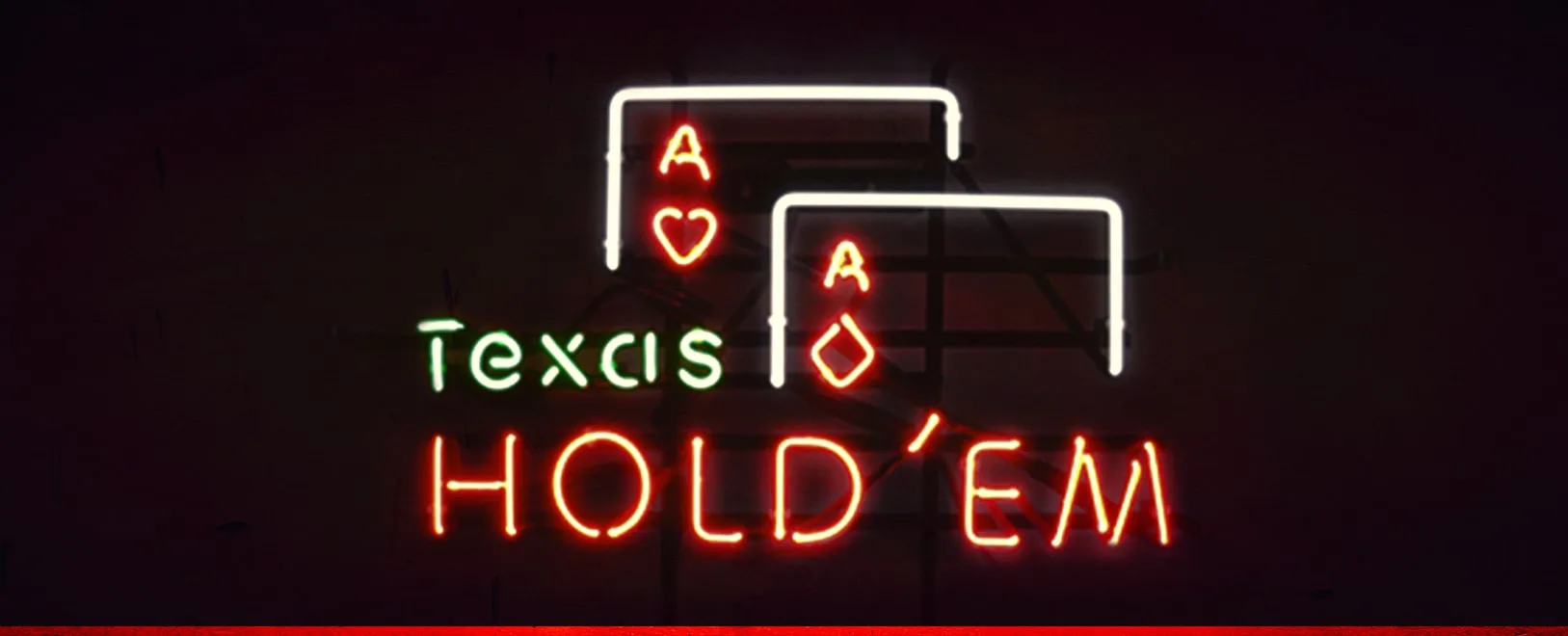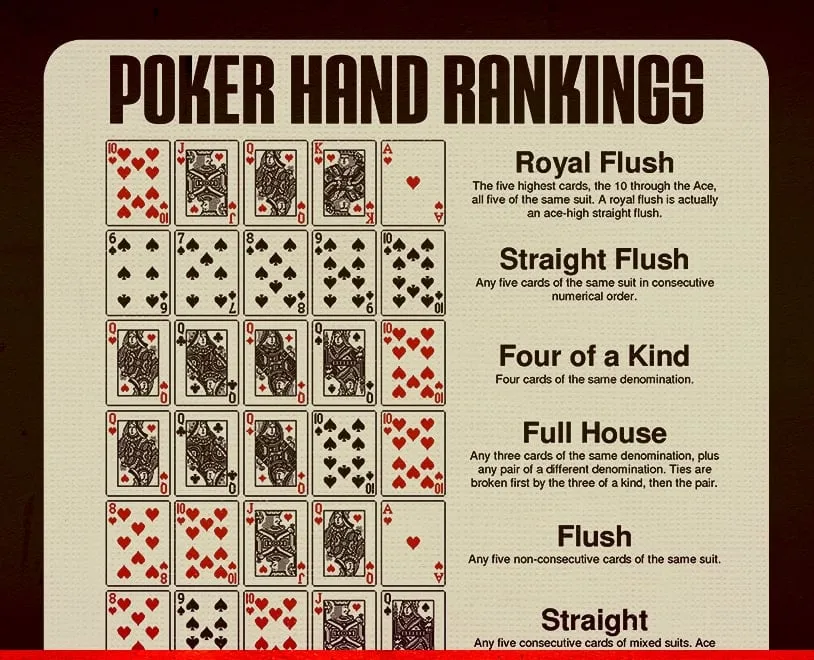
Download Poker

Texas Hold'em is widely regarded as the most popular variant of poker due to its abundant strategies and available training materials. Despite its seemingly complex nature, the game's rules are pretty straightforward and can be learned fairly quickly. Our Texas Hold’em guide will teach you about the various rules, hand rankings and combinations, how to place bets, and more. Once you’ve learned the basics, it put your knowledge into practice by practicing, then proceed to master the strategies necessary for a successful game.
The following tips will teach you how to play Texas Hold’em at the most basic level, focusing on the rules of the game. Once you’ve learned the rules, you’ll be ready to play the game for real money at Ignition Poker.
Playing Texas Hold'em poker requires a deck of cards and a table that accommodates players comfortably while preventing opponents from seeing each other's cards. This game uses a standard 52-card deck without jokers and you need poker chips to bet with. All players start off by being dealt two cards (known as hole cards) that are kept face-down and private. If required, the Dealer then flips over three community cards face-up in the middle of the table. These cards are shared by all the players. You can use any combination of hole cards and community cards to create a five-card poker hand. Again, if required, the Dealer will flip over two more community cards, one at a time, for a maximum of seven cards you can use to make your five-card poker hand. The goal is to get the strongest possible five-card combination of cards, which can be made up of the two cards dealt to the player and the five community cards on the table.
The number of players at the table can range from 2 to 10, depending on the rules of the establishment or mutual agreement among players. Online rooms typically sort cash games and tournaments by the number of seats available, which are marked accordingly, such as 2-max, 6-max & 9-max.
Occasionally, other tables such as 3-max may be used, such as in the special Spin&Go jackpot mini-tournaments designed for three players.
 In Texas Hold'em terms, a "Button" chip (actually a disk, a bit larger than the poker chips) is often used to indicate the nominal dealer and to maintain the sequence of moves. The dealer, marked by the button, acts last and is followed by the blinds, who act last in the preflop betting round (as they have already made blind bets). In both online and offline poker games, the cards are dealt by the program or a professional dealer, rather than by the participants themselves. However, in a home game, the player with the button typically acts as the dealer. Additionally, players may also use chips with monetary value, called "chips", which can come in different denominations or be of the same value.
In Texas Hold'em terms, a "Button" chip (actually a disk, a bit larger than the poker chips) is often used to indicate the nominal dealer and to maintain the sequence of moves. The dealer, marked by the button, acts last and is followed by the blinds, who act last in the preflop betting round (as they have already made blind bets). In both online and offline poker games, the cards are dealt by the program or a professional dealer, rather than by the participants themselves. However, in a home game, the player with the button typically acts as the dealer. Additionally, players may also use chips with monetary value, called "chips", which can come in different denominations or be of the same value.
To ensure fair-play, the dealer button moves one position clockwise after each hand. This allows each player to take turns placing the small and big blinds and playing from each position at the table during a round of hands. As a result, every player has an equal opportunity to act in each position. At the casino, or at fancy home games, an employee who’s not in the game will take care of the dealing. The Dealer button will still be passed around from player to player
 When playing classic poker, mandatory bets known as "blinds" must be made before the hand begins. These bets are made by two participants sitting to the left of the dealer and are placed before receiving the hole cards. The two types of blinds are the small blind and the big blind. The small blind is positioned immediately to the left of the dealer, and the big blind is located to the left of the small blind.
When playing classic poker, mandatory bets known as "blinds" must be made before the hand begins. These bets are made by two participants sitting to the left of the dealer and are placed before receiving the hole cards. The two types of blinds are the small blind and the big blind. The small blind is positioned immediately to the left of the dealer, and the big blind is located to the left of the small blind.
In most games, the big blind is always twice the amount of the small blind. This is another reason why it’s important to pass the Dealer button around after every hand, ensuring that everyone at the table contributes the blinds in equal measure. For example, if the small blind is $1, then the big blind would be $2. It's important to note that while the blinds in cash games remain the same throughout the game, the size of the blinds in tournaments constantly increases over time. Added contributions known as antes may also be required from each player at the table before the start of every hand.
Texas Hold'em is played no different compared to basic poker rules with over several rounds of betting, and we'll guide you through each step of the process.
During a single hand of Texas Hold’em, a round of betting will take place after each deal of the cards, starting with the two hole cards. The poker chips come in different denominations; if you’re playing a cash game, those denominations represent real money. If you’re playing a poker tournament, the chips are more like points, with the prize money awarded to the longest-lasting survivors in the game. Each bet is placed in the middle of the table, creating a pile of chips known as the pot. After someone bets, the next player to the left can either raise (by putting a larger amount of chips in), call (by putting in the same number of chips), or fold (by putting the hole cards in the middle). The pot goes to the last player standing, or whoever has the best poker hand when all seven cards have been dealt. Then it’s on to the next hand.
A hand of Texas Hold’em can be divided into two parts: pre-flop, and post-flop. The first three community cards are typically referred to as the flop, so the set of decisions that players make before those cards are dealt is called the pre-flop action. First, the Dealer will give everyone a single card, face-down, starting with the player in the small blind. Then the second hole card will be dealt in the same fashion. Pre-flop action always begins with the player to the left of the big blind; this position at the table is called under the gun.
Once the hole cards are dealt, the player under the gun has three options: raise, call, or fold. In this case, a call will match the size of the big blind, which is considered a bet in poker. Again, the raise must be at least twice the size of the big blind – unless the player doesn’t have that many chips, in which case they must go all-in or fold. Once the player under the gun has taken their turn, the next player to the left can either raise, call or fold. This procedure continues around the table to the big blind, who has the same three options.
At this point, if there are two or more players left in the hand, and there is still a raise that has yet to be called, the action continues around the table until the last player left to act closes the betting round by calling or folding. If one of the remaining players has gone all-in, whoever is still in the hand will turn over their hole cards, the Dealer will put all five community cards on the table, and the winning hand will be declared. This is known as the showdown, which we’ll discuss more in a moment.
Another way a hand can end during the pre-flop action is if all of the players fold their hole cards before it’s the big blind’s turn. If this happens, the big blind takes the pot in what is known as a walk. Otherwise, the hand will continue, and the Dealer will put out the first three community cards.
Once the pre-flop betting round ends and there are still multiple players involved in the hand, the dealer reveals the first three community cards. The standard betting rules of Texas Hold’em apply, but the player seated in the small blind position or, if that person has already folded, the next active player closest to the left of the dealer in a clockwise direction is the one who initiates the betting round. The button or the next active player to their right is the one who acts last.
Since there aren’t any blinds to put in at this point, the first player to act once the flop has been dealt has three options: bet, check, or fold. A check is essentially a bet of zero chips. In theory, all the players at the table can check, and the next community card will be dealt. If someone eventually makes a bet, the next player can raise, call or fold, just like pre-flop betting. This round of betting continues until someone wins the pot or the action is closed; if it’s the latter, the next community card is dealt.
The fourth community card is placed face up on the table, providing players with the opportunity to improve their current hand or maintain their current hand if the new card does not help. A new betting round begins.
The final community card is known as the river. Once the players reach this stage, there are no more cards to be dealt; if someone closes the action by calling, the previous bettor reveals their hole cards, and the caller has the option of folding their cards face-down if they’ve lost, or turning them over if they’ve won. If someone is all-in by this point, which often happens on the river, then the players go to showdown.
The showdown is the thrilling conclusion of a poker hand, and it’s even more exciting on the river. Once the all-in has been called (or raised) and everyone else either joins in or folds, the players left in the hand turn their cards over, and the winner is declared. If two or more players are tied with the best hand, they split the pot evenly. Some games will allow you to run it twice, meaning a second set of community cards will be dealt, and the pot will be split between whoever wins on the first run-out and whoever wins the second.
A split, also known as a tie or chop, occurs in poker when multiple players have equally strong hands at showdown. In such cases, the pot is divided among the players. It's important to note that a split pot can only occur at showdown and can involve multiple players. The method used to obtain the hand (whether from the cards on the table or from the player's own hand) is irrelevant in determining a split.
In such scenarios, the importance of the kicker in poker becomes evident. A kicker is an extra card that is not part of the main combination, but it can determine the winner in the event of a tie. For instance, let's consider the following example:
During a showdown, three players remain: one has A2, the second has KQ, and the third has a pair of jacks. The community cards on the table are 99399, and all players have four of a kind.
It's important to note that in Texas Hold'em, a combination is made up of five cards, just like in Omaha rules, but there you have four hole cards instead of two. Thus, if you have four of a kind, your hand will consist of 9999 plus one additional card (kicker). Therefore, the player with A2 wins the hand is his Ace kicker is higher than the other players’ kicker.
In poker, the card with the lowest face value is the deuce, while the card with the highest value is the ace. It is important to note that the ace can also be used as the lowest card in the lowest straight combination, which is A-2-3-4-5. However, this is the only exception, as in all other cases, the ace is considered the strongest card in the deck. The hand values in Texas Hold’em use the conventional poker hand rankings, with the famous and rare Royal Flush (Ace-King-Queen-Jack-Ten of the same suit) at the top of the list.
Identifying the Texas Hold’em combinations by heart is crucial for understanding the game and assessing your chances of winning. Although players have access to seven cards in No Limit Hold’em, only five cards are used to form a hand. Below are the poker combinations ranked from weakest to strongest:

Playing online Texas Hold'em at Ignition is a straightforward and exciting experience. After creating an account and logging in, head to the poker section and select the Texas Hold'em game of your choice. Ignition offers a variety of cash games and tournaments with different buy-ins and table sizes to suit your preferences. Take your seat at the virtual table, and the action begins. Use the intuitive controls to make your betting decisions, whether it's folding, calling, raising, or going all-in.
Texas Hold'em online cash games are a popular form of online poker. Unlike tournaments, there are no fixed start and end times, and players can join and leave at any time. Stakes vary from micro to high, and players can choose the level they're comfortable with. Playing multiple tables can increase the chances of winning, but players should exercise good bankroll management to avoid losses.
Cash games and tournaments are two different formats of poker. In cash games, players buy-in for a certain amount of money and can leave at any time, taking their chips and winnings with them.
Playing online Texas Hold'em tournaments at Ignition adds an extra level of excitement to your poker experience. To participate, log in to your account and navigate to the tournament section. There, you'll find a diverse range of tournaments with various buy-ins and formats. Choose the tournament that suits your preferences and register. Once the tournament begins, you'll be assigned a seat at the virtual table.
In classic tournaments, players receive equal starting stacks, and blinds increase after a certain time or number of hands played. The higher the place, the bigger the prize. As the number of participants decreases, players are seated at the vacant seats.
It's important to note that chips in tournaments do not have a fixed monetary value, and if a player leaves the table, chips are still deducted from their stack to pay for the blinds until they run out.
Texas Hold'em is a popular variant of poker that is played with a standard deck of 52 cards. It involves two hole cards and five community cards that are shared by all players.
To play Texas Hold'em, each player is dealt two hole cards face down, followed by a round of betting. Then, three community cards are dealt face up (the flop), followed by another round of betting. A fourth community card (the turn) is dealt, followed by more round of betting. Finally, a fifth community card (the river) is dealt, and a final round of betting takes place. The player with the best five-card hand wins.
The basic rules of Texas Hold'em include a forced small blind and big blind bet before the start of each hand, and the option for players to fold, call, or raise during each round of betting. The highest ranking hand wins.
The hand rankings in Texas Hold'em, from highest to lowest, are: royal flush, straight flush, four of a kind, full house, flush, straight, three of a kind, two pair, one pair, and high card.
Strategies for playing Texas Hold'em include understanding the value of position, managing your bankroll, and reading your opponents' behavior and betting patterns. It is also important to know when to fold and when to bluff.